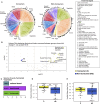Regular consumption of lacto-fermented vegetables has greater effects on the gut metabolome compared with the microbiome
- PMID: 39295909
- PMCID: PMC11406409
- DOI: 10.1017/gmb.2023.9
Regular consumption of lacto-fermented vegetables has greater effects on the gut metabolome compared with the microbiome
Abstract
The industrialisation of Western food systems has reduced the regular consumption of lacto-fermented vegetables (LFV). Consuming LFV may exert health benefits through the alteration of the gut microbiome, but the mechanisms involved remain unclear. To start understanding the possible benefits of LFV, we compared faecal microbial diversity and composition, as well as dietary habits between individuals who regularly consume LFV (n = 23) and those who do not (n = 24). We utilised microbial DNA amplicon sequencing (16S rRNA and ITS2) and untargeted metabolomics (LC-MS) to analyse stool samples. Study participants also provided three consecutive days of dietary data. Results show minor effects on microbiome composition; with the enrichment of a few microorganisms potentially associated with vegetable ferments, such as Leuconostoc mesenteroides and Rhodotorula mucilaginosa (P < 0.05), in LFV consumers. However, LFV consumption had greater effects on the faecal metabolome, with higher abundances of butyrate, acetate, and valerate (P < 0.05) and significantly greater metabolome diversity (P < 0.001). Overall, the observations of minor changes in the faecal microbiome and greater effects on the faecal metabolome from LFV consumption warrant further investigations on the health significance of LFV as regular components of the daily diet in humans.
Keywords: dietary diversity; fermented foods; gut metabolome; gut microbiome; lacto-fermented vegetables; short-chain fatty acids.
© The Author(s) 2023.
Conflict of interest statement
The authors declare none.
Figures





Similar articles
-
Consumption of Fermented Foods Is Associated with Systematic Differences in the Gut Microbiome and Metabolome.mSystems. 2020 Mar 17;5(2):e00901-19. doi: 10.1128/mSystems.00901-19. mSystems. 2020. PMID: 32184365 Free PMC article.
-
Bifidobacterium longum-fermented rice bran and rice bran supplementation affects the gut microbiome and metabolome.Benef Microbes. 2019 Dec 9;10(8):823-839. doi: 10.3920/BM2019.0017. Epub 2019 Sep 29. Benef Microbes. 2019. PMID: 31965839 Free PMC article.
-
The unique composition of Indian gut microbiome, gene catalogue, and associated fecal metabolome deciphered using multi-omics approaches.Gigascience. 2019 Mar 1;8(3):giz004. doi: 10.1093/gigascience/giz004. Gigascience. 2019. PMID: 30698687 Free PMC article.
-
Lacto-fermented sauerkraut improves symptoms in IBS patients independent of product pasteurisation - a pilot study.Food Funct. 2018 Oct 17;9(10):5323-5335. doi: 10.1039/c8fo00968f. Food Funct. 2018. PMID: 30256365 Clinical Trial.
-
Fermented Foods, Health and the Gut Microbiome.Nutrients. 2022 Apr 6;14(7):1527. doi: 10.3390/nu14071527. Nutrients. 2022. PMID: 35406140 Free PMC article. Review.
Cited by
-
Impact of Novel Foods on the Human Gut Microbiome: Current Status.Microorganisms. 2024 Aug 23;12(9):1750. doi: 10.3390/microorganisms12091750. Microorganisms. 2024. PMID: 39338424 Free PMC article. Review.
-
Fermented foods, their microbiome and its potential in boosting human health.Microb Biotechnol. 2024 Feb;17(2):e14428. doi: 10.1111/1751-7915.14428. Microb Biotechnol. 2024. PMID: 38393607 Free PMC article. Review.
-
Modulating the human gut microbiome and health markers through kombucha consumption: a controlled clinical study.Sci Rep. 2024 Dec 30;14(1):31647. doi: 10.1038/s41598-024-80281-w. Sci Rep. 2024. PMID: 39738315 Free PMC article. Clinical Trial.
References
-
- Amato KR, Chaves ÓM, Mallott EK, et al. (2021) Fermented food consumption in wild nonhuman primates and its ecological drivers. American Journal of Physical Anthropology 175(3), 513–530. - PubMed
-
- ASA24 Dietary Assessment Tool (2018). Available at https://epi.grants.cancer.gov/asa24/ (accessed 11 November 2022).
LinkOut - more resources
Full Text Sources
